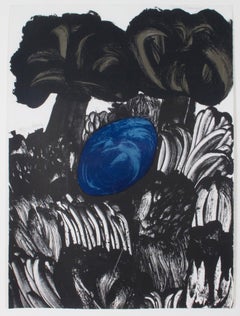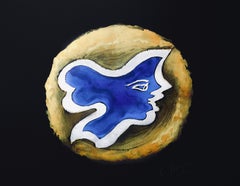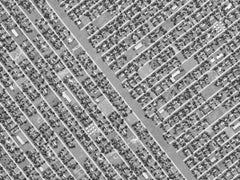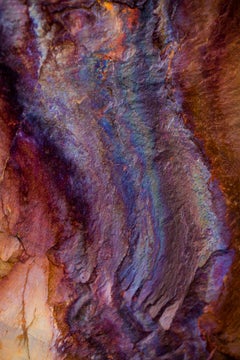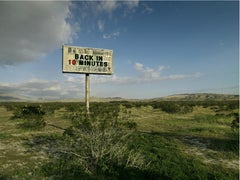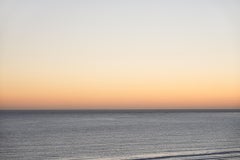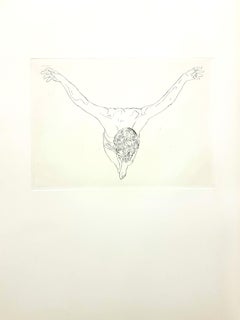Gem Landscape Prints
to
2
1
2
2
1
Overall Width
to
Overall Height
to
2
1
1
1
1
1
1
1
4
2
2
1
1
3
2
423
7,530
3,786
3,147
2,344
1,866
1,711
1,651
1,619
1,572
1,216
1,095
1,026
983
881
845
737
589
532
529
3
1
1
1
1
6
Art Subject: Gem
"Jungle, " Color Lithograph Landscape signed by Carol Summers
Located in Milwaukee, WI
"Jungle" is an important, rare color lithograph signed by Carol Summers from the early years of his production. The image offers a landscape of a dark jungle, printed mostly in black ink. In the center, a blue pool of water is shaded by two trees. Summers' technique in this print renders a painterly quality to the image: the grasses and leaves of the scene are all created with playful, energetic swiping motions much like watercolor paint. This technique and the use of fields of color predict the style Summers would adopt in the coming decades, making this an important early work.
30 x 22 inches, artwork
Numbered 14 of the edition of 27
Carol Summers (1925-2016) has worked as an artist throughout the second half of the 20th century and into the first years of the next, outliving most of his mid-century modernist peers. Initially trained as a painter, Summers was drawn to color woodcuts around 1950 and it became his specialty thereafter. Over the years he has developed a process and style that is both innovative and readily recognizable. His art is known for it’s large scale, saturated fields of bold color, semi-abstract treatment of landscapes from around the world and a luminescent quality achieved through a printmaking process he invented.
In a career that has extended over half a century, Summers has hand-pulled approximately 245 woodcuts in editions that have typically run from 25 to 100 in number. His talent was both inherited and learned. Born in 1925 in Kingston, a small town in upstate New York, Summers was raised in nearby Woodstock with his older sister, Mary. His parents were both artists who had met in art school in St. Louis. During the Great Depression, when Carol was growing up, his father supported the family as a medical illustrator until he could return to painting. His mother was a watercolorist and also quite knowledgeable about the different kinds of papers used for various kinds of painting. Many years later, Summers would paint or print on thinly textured paper originally collected by his mother.
From 1948 to 1951, Carol Summers trained in the classical fine and studio arts at Bard College and at the Art Students League of New York. He studied painting with Steven Hirsh and printmaking with Louis Schanker. He admired the shapes and colors favored by early modernists Paul Klee (Sw: 1879-1940) and Matt Phillips (Am: b.1927- ). After graduating, Summers quit working as a part-time carpenter and cabinetmaker (which had supported his schooling and living expenses) to focus fulltime on art. That same year, an early abstract, Bridge No. 1 was selected for a Purchase Prize in a competition sponsored by the Brooklyn Museum.
In 1952, his work (Cathedral, Construction and Icarus) was shown the first time at the Museum of Modern Art in New York City in an exhibition of American woodcuts. In 1954, Summers received a grant from the Italian government to study for a year in Italy. Woodcuts completed soon after his arrival there were almost all editions of only 8 to 25 prints, small in size, architectural in content and black and white in color. The most well-known are Siennese Landscape and Little Landscape, which depicted the area near where he resided. Summers extended this trip three more years, a decision which would have significant impact on choices of subject matter and color in the coming decade.
After returning from Europe, Summers’ images continued to feature historical landmarks and events from Italy as well as from France, Spain and Greece. However, as evidenced in Aetna’s Dream, Worldwind and Arch of Triumph, a new look prevailed. These woodcuts were larger in size and in color. Some incorporated metal leaf in the creation of a collage and Summers even experimented with silkscreening. Editions were now between 20 and 50 prints in number. Most importantly, Summers employed his rubbing technique for the first time in the creation of Fantastic Garden in late 1957.
Dark Vision of Xerxes, a benchmark for Summers, was the first woodcut where Summers experimented using mineral spirits as part of his printmaking process. A Fulbright Grant as well as Fellowships from the Louis Comfort Tiffany Foundation and the Guggenheim Foundation followed soon thereafter, as did faculty positions at colleges and universities primarily in New York and Pennsylvania. During this period he married a dancer named Elaine Smithers with whom he had one son, Kyle. Around this same time, along with fellow artist Leonard Baskin, Summers pioneered what is now referred to as the “monumental” woodcut. This term was coined in the early 1960s to denote woodcuts that were dramatically bigger than those previously created in earlier years, ones that were limited in size mostly by the size of small hand-presses. While Baskin chose figurative subject matter, serious in nature and rendered with thick, striated lines, Summers rendered much less somber images preferring to emphasize shape and color; his subject matter approached abstraction but was always firmly rooted in the landscape.
In addition to working in this new, larger scale, Summers simultaneously refined a printmaking process which would eventually be called the “Carol Summers Method” or the “ Carol Summers Technique”. Summers produces his woodcuts by hand, usually from one or more blocks of quarter-inch pine, using oil-based printing inks and porous mulberry papers. His woodcuts reveal a sensitivity to wood especially its absorptive qualities and the subtleties of the grain. In several of his woodcuts throughout his career he has used the undulating, grainy patterns of a large wood plank to portray a flowing river or tumbling waterfall. The best examples of this are Dream, done in 1965 and the later Flash Flood Escalante, in 2003. In the majority of his woodcuts, Summers makes the blocks slightly larger than the paper so the image and color will bleed off the edge.
Before printing, he centers a dry sheet of paper over the top of the cut wood block or blocks, securing it with giant clips. Then he rolls the ink directly on the front of the sheet of paper and pressing down onto the dry wood block or reassembled group of blocks. Summers is technically very proficient; the inks are thoroughly saturated onto the surface of the paper but they do not run into each other. The precision of the color inking in Constantine’s Dream in 1969 and Rainbow Glacier in 1970 has been referred to in various studio handbooks. Summers refers to his own printing technique as “rubbing”. In traditional woodcut printing, including the Japanese method, the ink is applied directly onto the block. However, by following his own method, Summers has avoided the mirror-reversed image of a conventional print and it has given him the control over the precise amount of ink that he wants on the paper. After the ink is applied to the front of the paper, Summers sprays it with mineral spirits, which act as a thinning agent. The absorptive fibers of the paper draw the thinned ink away from the surface softening the shapes and diffusing and muting the colors. This produces a unique glow that is a hallmark of the Summers printmaking technique. Unlike the works of other color field artists or modernists of the time, this new technique made Summers’ extreme simplification and flat color areas anything but hard-edged or coldly impersonal.
By the 1960s, Summers had developed a personal way of coloring and printing and was not afraid of hard work, doing the cutting, inking and pulling himself. In 1964, at the age of 38, Summers’ work was exhibited for a second time at the Museum of Modern Art. This time his work was featured in a one-man show and then as one of MOMA’s two-year traveling exhibitions which toured throughout the United States. In subsequent years, Summers’ works would be exhibited and acquired for the permanent collections of multiple museums throughout the United States, Europe and Asia. Summers’ familiarity with landscapes throughout the world is firsthand. As a navigator-bombardier in the Marines in World War II, he toured the South Pacific and Asia.
Following college, travel in Europe and subsequent teaching positions, in 1972, after 47 years on the East Coast, Carol Summers moved permanently to Bonny Doon in the Santa Cruz Mountains in Northern California. There met his second wife, Joan Ward Toth, a textile artist who died in 1998; and it was here his second son, Ethan was born. During the years that followed this relocation, Summers’ choice of subject matter became more diverse although it retained the positive, mostly life-affirming quality that had existed from the beginning. Images now included moons, comets, both sunny and starry skies, hearts and flowers, all of which, in one way or another, remained tied to the landscape.
In the 1980s, from his home and studio in the Santa Cruz mountains, Summers continued to work as an artist supplementing his income by conducting classes and workshops at universities in California and Oregon as well as throughout the Mid and Southwest. He also traveled extensively during this period hiking and camping, often for weeks at a time, throughout the western United States and Canada. Throughout the decade it was not unusual for Summers to backpack alone or with a fellow artist into mountains or back country for six weeks or more at a time. Not surprisingly, the artwork created during this period rarely departed from images of the land, sea and sky. Summers rendered these landscapes in a more representational style than before, however he always kept them somewhat abstract by mixing geometric shapes with organic shapes, irregular in outline. Some of his most critically acknowledged work was created during this period including First Rain, 1985 and The Rolling Sea, 1989. Summers received an honorary doctorate from his alma mater, Bard College in 1979 and was selected by the United States Information Agency to spend a year conducting painting and printmaking workshops at universities throughout India. Since that original sabbatical, he has returned every year, spending four to eight weeks traveling throughout that country.
In the 1990s, interspersed with these journeys to India have been additional treks to the back roads and high country areas of Mexico, Central America, Nepal, China and Japan. Travel to these exotic and faraway places had a profound influence on Summers’ art. Subject matter became more worldly and nonwestern as with From Humla to Dolpo, 1991 or A Former Life of Budha, 1996, for example. Architectural images, such as The Pillars of Hercules, 1990 or The Raja’s Aviary, 1992 became more common. Still life images made a reappearance with Jungle Bouquet in 1997. This was also a period when Summers began using odd-sized paper to further the impact of an image.
The 1996 Night, a view of the earth and horizon as it might be seen by an astronaut, is over six feet long and only slightly more than a foot-and-a-half high. From 1999, Revuelta A Vida (Spanish for “Return to Life”) is pie-shaped and covers nearly 18 cubic feet. It was also at this juncture that Summers began to experiment with a somewhat different palette although he retained his love of saturated colors. The 2003 Far Side of Time is a superb example of the new direction taken by this colorist.
At the turn of the millennium in 1999, “Carol Summers Woodcuts...
Category
1960s Contemporary Landscape Prints
Materials
Lithograph
Braque, Hecate, Œdipe roi de Sophocle (after)
Located in Auburn Hills, MI
Lithograph on grand vélin d'Arches pur chiffon spécialement fabriqués paper. Inscription: signed in the plate and unnumbered, as issued. Good condition. Notes: from the folio, Œdipe ...
Category
1980s Modern Landscape Prints
Materials
Lithograph
$956 Sale Price
20% Off
Composition (Field 69-3; M/L. 1600), VI tavole dal ciclo della, Biblia Sacra
Located in Auburn Hills, MI
Lithograph in colors on vélin Fabriano charta ex meris pannis "ab alveo" manu fabricata, perlucidis figuris intexta paper. Paper size: 19 x 13.75 inches. Inscription: Signed in the p...
Category
1960s Surrealist Figurative Prints
Materials
Lithograph
$1,116 Sale Price
20% Off
Light House, As an Arrow (plate)
By (After) Robert Rauschenberg
Located in New York, NY
for the Guggenheim Museum
The back of the plate has a facsimile autograph and "Exclusive Edition for the Guggenheim Museum" and is dated 1997
LIGHT HOUSE, AS AN ARROW ...
Category
1990s Pop Art Landscape Prints
Materials
Porcelain
Elmwood and Oaklawn
By Ross Racine
Located in New York, NY
archival pigment print
image size: 23.5"x 31.5" on 26.75"x 34.5" sheet
edition of 10
available unframed
This print is a surreal depiction of an aerial view of a ...
Category
2010s Conceptual Landscape Prints
Materials
Archival Pigment
Colorful Fine Art Prints, Landscape Photography, Rock Prints-Opalescent on Rush
Located in Delaware , OH
Colorful Fine Art Prints, Landscape Photography, Rock Prints-Opalescent on Rush
ABOUT THIS PIECE:
"Opalescent on Rush" was part of a landscape series shot...
Category
21st Century and Contemporary Contemporary Color Photography
Materials
Rag Paper, Color
Related Items
Back in 10 - large format photograph of conceptual message sign in landscape
By Frank Schott
Located in San Francisco, CA
large scale photograph from a series of conceptual motivational messages on classic Americana billboard signs in landscape of the American West
BACK I...
Category
21st Century and Contemporary Conceptual Color Photography
Materials
Archival Ink, Archival Paper, Photographic Paper, Archival Pigment, Giclée
Morning Glow - large format photograph of monochromatic water and horizon
By Frank Schott
Located in San Francisco, CA
Mesmerizing large scale photograph from artist's Seascape series, a body of works capturing the tactile surfaces and monochromatic nature of oceanic water and cloudscapes
Morning G...
Category
21st Century and Contemporary Contemporary Color Photography
Materials
Archival Ink, Archival Paper, Photographic Paper, Archival Pigment, Giclée
$4,400
H 48 in W 72 in D 0.03 in
Seascape X - large format photograph of monochrome blue water surface & horizon
By Frank Schott
Located in San Francisco, CA
Mesmerizing large scale photograph from artist's Seascape series, a body of works capturing the tactile surfaces and monochromatic nature of oceanic water and cloudscapes
Seascape ...
Category
21st Century and Contemporary Contemporary Color Photography
Materials
Photographic Paper, Archival Pigment, Archival Ink, Archival Paper, Giclée
YES - large format photograph of conceptual motivational message sign at night
By Frank Schott
Located in San Francisco, CA
large scale original photograph from a series of conceptual motivational messages on iconic Americana signs in landscape of the American West
YES by Frank Schott
48 x 67 inches (122 x 171cm)
signed edition of 7
29 x 40 inches (74 x 102cm)
signed edition of 25
archival quality fine art pigment print
limited art edition published by Edition EKTAlux
artist signed + numbered certificate of authenticity
_______________
Frank Schott grew up in Germany and attended the prestigious Academy of Arts in Cologne, studying under Professor Arno Jansen, who was an early influence.
Moving to California in 1998, Schott's work has evolved to include the epic landscapes and deserts of the American West as well as architectural, conceptual and more formal environments from both home and his travels.
Influenced by a number of photographic peers and precursors such as Candida Höfer, Andreas Gursky, Thomas Struth, Jeff Wall, Ed Rusha...
Category
21st Century and Contemporary Conceptual Color Photography
Materials
Giclée, Archival Ink, Archival Paper, Photographic Paper, Archival Pigment
YES - large format photograph of conceptual motivational sign at night
By Frank Schott
Located in San Francisco, CA
large scale original photograph from a series of conceptual motivational messages on classic Americana billboard signs in iconic landscape of the American West
YES by Frank Schott
...
Category
21st Century and Contemporary Conceptual Color Photography
Materials
Archival Ink, Archival Paper, Photographic Paper, Archival Pigment, Giclée
Billboard - large scale monochromatic photograph of iconic Americana road sign
By Frank Schott
Located in San Francisco, CA
a monochromatic photographic homage to artist Ed Ruscha from a series of iconic Americana roadside billboard signs and conceptual signage
BILLBOARD by Frank Schott
48 x 76 inches...
Category
21st Century and Contemporary Conceptual Color Photography
Materials
Archival Paper, Photographic Paper, Archival Pigment, Giclée
TODAY - large format photograph of conceptual motivational billboard at night
By Frank Schott
Located in San Francisco, CA
large scale original photograph of a billboard signage against ultramarine blue night sky from a series of conceptual motivational messages on iconic Americana signs...
Category
21st Century and Contemporary Conceptual Color Photography
Materials
Archival Paper, Photographic Paper, Archival Pigment, Archival Ink, Giclée
$4,400
H 48 in W 75.5 in D 0.03 in
MAYBE - large format photograph of conceptual motivational billboard at night
By Frank Schott
Located in San Francisco, CA
large scale photograph of a billboard signage against ultramarine blue night sky, from a series of conceptual motivational messages on iconic Americana roadside signs and billboards ...
Category
21st Century and Contemporary Conceptual Color Photography
Materials
Archival Paper, Photographic Paper, Archival Pigment, Giclée
$2,200
H 25.25 in W 40 in D 0.03 in
Dali, Femme à tete de Roses (Pittura N. Y415.35) (after)
Located in Fairfield, CT
Artist: Salvador Dali (1904-1989)
Title: Femme à tete de Roses (Pittura N. Y415.35)
Year: 2004
Medium: Lithograph on wove paper
Size: 30.25 x 22 inches
Condition: Excellent
Inscripti...
Category
Early 2000s Surrealist Landscape Prints
Materials
Lithograph
$2,360 Sale Price
20% Off
H 28 in W 22.25 in
Shepard Fairey "Respect Our Ocean" Screenprint Pacifico Beer Collaboration Urban
Located in Draper, UT
Edition Details:
Year: 2021
Class: Art Print
Status: Official
Numbered Run: 73/150
Technique: Screen Print
Paper: Thick Cream Speckletone
Size: 24 X 18
Markings: Numbered
"Shepard F...
Category
2010s Pop Art Landscape Prints
Materials
Screen
La Espera (The Wait -- Three Women by the sea)
Located in New Orleans, LA
The Wait. Three native Mexican women wait by the sea. This impression is #31/100. An impression of this lithograph is in the permanent collectio...
Category
Mid-20th Century Modern Figurative Prints
Materials
Lithograph
$506 Sale Price
40% Off
H 18 in W 14 in
Venice Seascape Triptych, Blue Lido Island Reflections, Contemporary Cyanotype
By Kind of Cyan
Located in Barcelona, ES
This series of cyanotype triptychs showcases the beauty of nature scenes, including stunning beaches and oceans, as well as the intricate textures of water, forests, and skies. These...
Category
2010s Contemporary Abstract Prints
Materials
Lithograph, Monotype, Paper
$744 Sale Price
20% Off
H 40 in W 83 in
Previously Available Items
Salvador Dali - Christ Study - Etching
Located in Collonge Bellerive, Geneve, CH
TITLE : Christ Study
MEDIUM : Etching
YEAR : 1951
PAPER : Vellum
SIZE : 11 x 15"
REFERENCES : Field 51-1 A - Michler & Lopsinger 62
This etching was created for the frontispice of ...
Category
1950s Surrealist Still-life Prints
Materials
Etching
